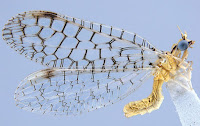Spongeflies, Sisyridae, are Neuropteran Insects related to Dustywings and Brown Lacewings. The adults closely resemble Brown Lacewings, but the larvae are very different, being aquatic, which is unusual in Neuropterans, and parasitic on Freshwater Sponges and Bryozoans. There are about 60 species living today, but like other Neuropterans the group is ancient, with a fossil record going back to the Crecaceous, and modern Spongeflies are probably less diverse than the ancient members of the group.
In a paper published in the journal Zootaxa on 26 August 2016, Wilfried Wichard of the Institute of Biology at the University of Koeln, Sonja Wedmann of the Senckenberg Forschungsstation Grube Messel, and Thomas Weiterschan of Höchst im Odenwald describe a new species of Spongefly from Eocene Baltic Amber.
The new species is placed in the genus Paleosisyra, which includes two previous species described from Baltic Amber, and given the specific name minor, meaning 'small' in Latin, due to the small size of the specimen, which has a forewing length of only 3.5 mm (compared to 4.0-5.2 for other members of the genus. The species is described from a single well preserved male specimen preserved in a piece of almost clear Baltic Amber.
Paleosisyra minor. Male in dorsal view; right forewing apically distored, left forewing length 3.5 mm. Wichard et al. (2016).
See also...
 Butterflies of the Jurassic: Convergent evolution between Mesozoic Kalligrammatid Lacewings and modern Butterflies. Kalligrammatid Lacewings first appeared in the fossil record in the
Middle Jurassic, about 160 million years ago, and disappeared in the
Early Cretaceous about 115 million years ago. They were...
Butterflies of the Jurassic: Convergent evolution between Mesozoic Kalligrammatid Lacewings and modern Butterflies. Kalligrammatid Lacewings first appeared in the fossil record in the
Middle Jurassic, about 160 million years ago, and disappeared in the
Early Cretaceous about 115 million years ago. They were...  Glenochrysa minima: A new species of Green Lacewing from Western Australia. The Neuroptera, or Net-winged Insects, first appeared in the Permian and
reached their maximum diversity in the Permian, when they were the most
numerous Insects...
Glenochrysa minima: A new species of Green Lacewing from Western Australia. The Neuroptera, or Net-winged Insects, first appeared in the Permian and
reached their maximum diversity in the Permian, when they were the most
numerous Insects... A Silky Lacewing from the Eocene of Washington State. Silky Lacewings (Psychopsidae) are a group of Neuropteran Insects that
are rare today, with only...
A Silky Lacewing from the Eocene of Washington State. Silky Lacewings (Psychopsidae) are a group of Neuropteran Insects that
are rare today, with only...
Follow Sciency Thoughts on Facebook.

